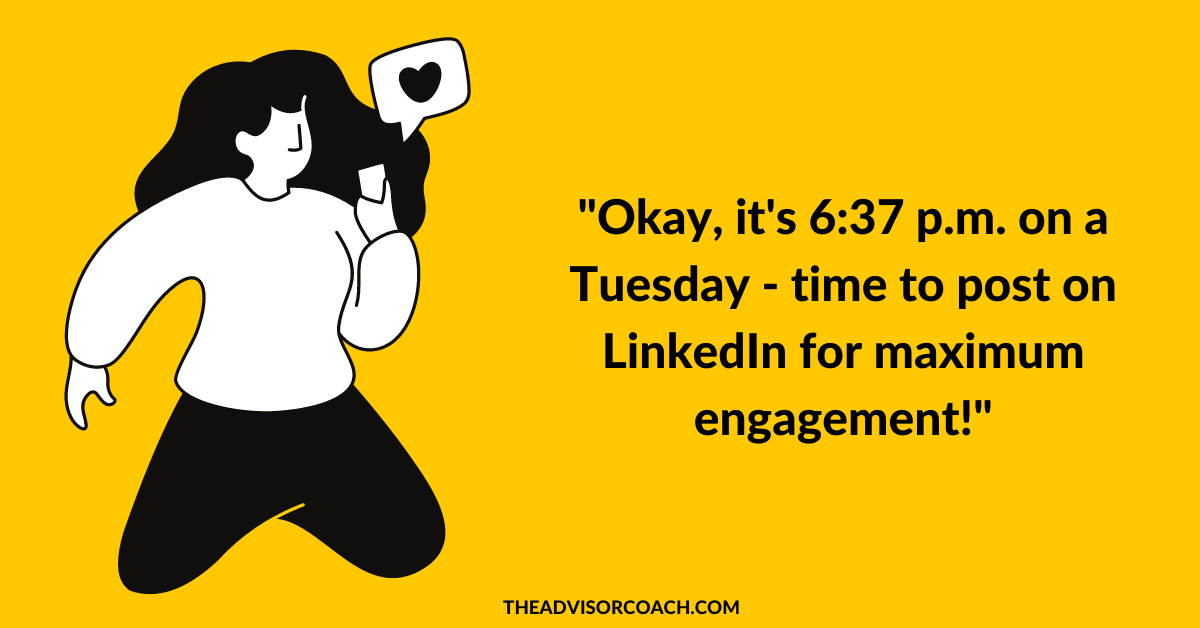7 Easy & Actionable Social Media Marketing Tips For Financial AdvisorsIn order for a business to grow, it needs to market its products and services. The financial services industry is no different.
No longer considered a passing trend, social media is here to stay, and it can be leveraged as a powerful marketing strategy. Financial advisors can use social media to put themselves in front of more prospects. Here’s a peek at what we’ll cover in this article: The Importance of Social Media Marketing for Financial AdvisorsSocial media is important to financial advisors because more and more people are looking to social media for investment information. Don’t believe me? A study done by Sysomos (a social media software provider) and Marketwired (a business news data channel) found that between 60-70% of all investors used “traditional” sources to get investment information. That means newspapers, analyst reports, etc.
But… between 40-60% of respondents said that they used information from social media when making in investment decisions. Another study done by Accenture shows that 48% of financial advisors use social media to interact with investors on a daily basis. That means over half of financial advisors aren’t doing it, and that’s sad. What’s even sadder is that 9% of investors surveyed by Accenture say that firms that don’t leverage social media will lose clients. What if I chopped your income down 9% right now? That’s what’s happening, and the scariest part? That 9% figure is only going to get higher… Wait... How Does Your Website Look?In the context of business and making money (which is the goal here), social media exists for you to generate leads. You generate leads by sending them to your website, where they will perform some action you want them to perform, whether that’s subscribing to an email list, opting in for a free report, or setting an appointment with you.
ALSO READ THIS: Why Most Financial Advisor Websites Suck That’s why it’s CRITICAL for you to get your website in order before you send over a single visitor. I mean, don’t you clean your house before having people over for dinner? Well, I hope you do, but if you’re anything like me, your idea of cleaning is “sweeping” the room with a glance. Ha! Anyway, you don’t want website visitors to say things like, “I found the screen too confusing” or “I didn’t know what to do next”. The goal of social media should be to send people to your website. The goal of your website should be to turn visitors into leads. If you can't do that, then your inbound marketing machine will be a failure. You've been warned... (Also, if you want to learn how to build an email marketing machine that gets people to set an appointment with you, check out this webinar.) When Should You Post On Social Media?This is a pretty common question that I get from financial advisors about social media marketing. But there are no universal truths when it comes to marketing. For example, have you ever noticed that the really cheesy infomercials tend to run around 3:00 in the morning? Why is that?
I’m not quite sure, but if I had to guess, I would assume that people in the infomercial business know that the people who are most likely to purchase their products are watching TV late at night and early into the morning. Maybe we have poor judgment in those wee hours… who knows? So if you’re up at 3 a.m. watching TV, you’re probably a prime target for them. But what about your prospect? Here are some rules of thumb:
Take these times with a grain of salt. I am NOT saying that you should only post to social media during those times because I don’t want you to avoid taking action. What I am saying is that these are the best AVERAGES. If you're a financial advisor who specializes in working with educators, you probably DON'T want to follow this advice because your target market will be in school teaching the children during the "best times". Use your common sense and tailor your approach to your market. Social Media Marketing Tips for Financial Advisors1. Know Who You're Targeting
With social media, you can potentially reach millions of people. However, the real magic of social media comes when you determine, in advance, the audience to whom you wish to market yourself. Both Facebook and LinkedIn have thousands of groups. These are places where people who share a common interest get together. If these people are in your target market, you need to hang out where they hang out. Plus, social media platforms typically offer hyper-targeted ads that can be delivered to the exact type of person you want to reach. For example, someone I know sells coloring books for adults. He found out that the ideal customer for his product was a 34-year-old woman who likes meditation AND yoga. Because of social media, he can do something called “layered targeting” (where he only targets people who like both meditation and yoga) and develop an incredibly focused marketing strategy. You want to narrow your focus when advertising because the wider you cast your net, the less likely you are to get high engagement rates. If you don’t get high engagement rates, the more you will pay for your ads. Need a niche? Read 5 Best Niches for Financial Advisors 2. Engage with others and respond to prospects’ queries. Social media is never really “off”, so if you’re only logging in once a month, you’re missing out. If you’re continually sharing engaging content on social media, you have to keep track of responses and feedback given by other social media users. If you’re doing social media “right”, then it will lend itself directly to real relationship building. I don’t necessarily mean posting every meal on Instagram or Snapchatting your every waking moment. What I mean is giving the world an update on how your business is doing - have you had any recent successes, challenges, setbacks, or awards? Plus, a strong social media presence plays a big role in building brand loyalty. A report published by Texas Tech University found that brands who are active on social media have more loyal customers, probably because they are constantly interacting and engaging. ALSO READ: 4 LinkedIn Tips for Financial Advisors 3. Leverage any charitable functions, events or press. If you are sponsoring a charity fundraiser, attending a major trade show, or volunteering your time at a charitable organization, post it on social media! Depending on the time and context, you could even be picked up by news outlets. In my own life, I support Donors Choose because it allows me to give directly to classrooms across America. I talk about Donors Choose on social media and how proud I am of the work we do over at The Advisor Coach. These types of posts almost always get above-average engagement. However, please refrain from getting involved with charities simply to get exposure. People can tell when you aren't being genuine. In my case, I truly believe that supplying low-income classrooms with materials and resources is the right thing to do and people can see my passion. If you are picked up by a news outlet (assuming it’s for something positive), spread it all over social media. This is called “newsjacking”, and it helps to shine the spotlight in your direction. 4. Learn about your prospects, clients, and competitors. Social media lets you peek into other people’s lives. Whether it’s that girl snapping a picture of her fancy Starbucks drink or that neighbor of yours with the Mercedes S-Class (you can’t quite figure out what he does for a living…), all these networks give us a glimpse of what people value and what’s going on. When you learn more about your prospects and clients, you have some talking points for when you meet with them. Plus, it allows you to stay in front of them during the times that they aren’t on the phone with you or in your office. In the same way that financial advisors can learn about their prospects and clients, they can also learn about their competition. Is one of your competitors doing well on social media? Does it seem like his or her posts get tons of engagement, while yours are ice-cold? When that happens, you should take a moment to analyze what they’re doing that you aren’t. Once you learn which types of content work well for your audience, you can leverage that information outside of social media into your website, direct mail pieces, email marketing, and more. Because if someone resonates with your niche on one channel, it'll likely resonate across others as well. Take a look at what they post, who they follow, who follows them, and their most popular posts. This will help you understand what’s working for your competition and why they’re successful with their social media. 5. Use it for content distribution. The real power behind social media is the ability to scale. If you have a piece of relevant content, you can get in front of thousands of people, quickly. Imagine writing an article about planning for retirement in your fifties and targeting that piece of content, via Facebook ads, exclusively to people in their fifties. Or if you already have some followers, fans, or connections, you can share that piece of content with them. Never before has this been possible. LinkedIn is especially cool because it has Pulse. If you’re not familiar, Pulse is a publishing platform on LinkedIn that allows people to self-publish their own content. It’s what you see by your status update that says, “publish a post”. Pulse stands out in social media because it allows people to showcase their expertise to interested audiences. One of the most effective things financial advisors are doing right now is sending people from social media to their email opt-in page. This works well because it gets people away from "rented land" (after all, you don't control social media) to "owned land" (because you DO control your email list). Using social media for content distribution is especially powerful because it gets your prospects to consume your message in multiple places. Continuing with the email example, your prospects may get an email from you in the morning, as well as see you every night when they log in to their social accounts. This works wonders for building familiarity in your market. This is also great for overcoming skepticism. Because a prospect may initially interact with you on social media but avoid reaching out to you directly because of skepticism. However, once that prospect views your website, joins your email list, etc. then he/she is more likely to accept you as legitimate. ALSO READ: 9 Awesome Content Marketing Tips for Financial Advisors 6. Pay attention to your company’s social media policies. I’m not going to delude you: some financial services companies are WAY behind when it comes to social media. It blows my mind that some of these places are still in the stone ages. But if you happen to work at one of these companies, you still need to respect their policies. For example, many firms prohibit LinkedIn endorsements. That’s a decent policy because it helps you avoid the appearance of a testimonial. Not being able to create, publish, and promote content is another story entirely. Some firms only let you share content from a library of pre-approved content. That’s boring and I personally get tired of seeing the same tired status updates from advisors who work at these companies. But if that’s the company you chose, you must fall in line. 7. Don’t forget about your bottom line. Okay, enough with the cute stuff. Let’s get down to the nitty-gritty. In my opinion, this is the most important tip because, in the context of this article, financial advisors will be using social media for business purposes. And if this is the case, the goal is to make money. “Building a community” is nice, but actually being profitable is better. If you are hyper-focused on metrics such as new likes, comments, reach, etc. you are doing it wrong. You can’t go to the bank and deposit “likes”. When it comes to social media, this is what you need to focus on:
And that’s pretty much it. If you’re having trouble making social media give you a positive ROI, feel free to reach out to me. But I’m not going to give you a bunch of smoke and mirrors - at the end of the day, you need to know how many leads you can generate and if you’re profitable at that particular cost per lead. Let’s say that you are running a Facebook ad right now and you’re sending people to a piece of content you created with an opt-in form to set an appointment with you. Let’s also assume that each click costs you 50 cents and out of every 40 clicks, one person sets an appointment. Now let’s do some math… NOTE: I'm using OptinMonster to collect my email addresses. Check out my review of OptinMonster here. 50 cents X 40 clicks = $20 per appointment. Then let’s say that out of every five appointments you have, you convert one person into a paying client. That means 5 appointments X $20 per appointment = $100 per new client. Boom. You just figured out your customer acquisition cost. Now the question is….are you profitable if you acquire a customer for $100? For most financial advisors, the answer is a resounding YES. And guess what? I didn’t even mention uber-powerful tools like capturing emails, developing an autoresponder sequence, or retargeting. All of these things are designed to lower your customer acquisition cost even more. NOTE: I currently use Drip as my own personal email autoresponder and I highly recommend it. If you have any questions about it, feel free to reach out to me. You can also check out my review of Drip here. What if you could acquire a new client for $80? Or $50? Or even $20 or less? THAT, my friends, is the true power of social media. Here’s an awesome tip that will save you a bunch of money: use your best-performing content or opt-in. Online advertising is NOT meant to be a testing ground, playground, or proving ground. It’s meant to be a money-making machine. Every single click costs you money. The sad thing is that not everyone who clicks on your link is going to do what you want, whether that’s joining your email list or scheduling an appointment with you. So with that being said, you need to put your best and highest-converting content out there in order to make your dollars stretch as far as possible. ALSO READ: 9 Facebook Marketing Tips for Financial Advisors A Few Things I've Learned From Working With Financial Advisors...First of all, most financial advisors are severely underutilizing social media. The few advisors who are using social media are absolutely crushing it.
I’ve noticed that many financial advisors try to please everyone on social media. For example, they will share content about budgeting, saving, retirement planning, etc. that apply to everyone. This approach is like banging your head against the wall. The key to making social media work for financial advisors (and work really, REALLY well) is to target a niche and engage with that niche. It sounds simple because it is. Imagine a financial advisor who has 5,000 connections on LinkedIn but no niche. That advisor could share general content all day long and it may or may not get any traction. Compare that to a financial advisor who works exclusively with teachers, yet only has 2,500 connections on LinkedIn. If that financial advisor shares a piece of content that is specific to teachers (such as a blog article titled “7 Retirement Mistakes Teachers Make”), he or she is much more likely to get engagement and appointments as a result of that content. By the way - you do NOT have to share content and engage with other people to make social media work. I know there are some firms that don’t allow that activity. The key is to pick a market and go where that market hangs out. And one final note… Social media is NOT about being an “influencer”. It’s NOT about building goodwill or giving “value!”... no matter what the fancy social media companies tell you. For financial advisors, social media is about finding prospects and getting those prospects to set appointments with you. Period. Your social media should be set up to make that happen. |




